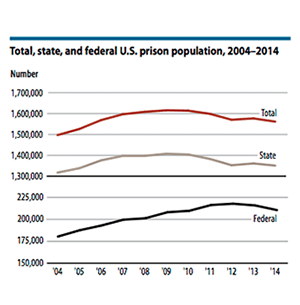Newly Released Report Shows National Prison Population Lowest Since 2005
 The national prison population fell 1 percent from 2013 to 2014—down 15,400 to 1,561,500—making it the smallest total prison population since 2005, according to the U.S. Department of Justice’s Bureau of Justice Statistics’ Prisoners in 2014 report, which was released in September.
The national prison population fell 1 percent from 2013 to 2014—down 15,400 to 1,561,500—making it the smallest total prison population since 2005, according to the U.S. Department of Justice’s Bureau of Justice Statistics’ Prisoners in 2014 report, which was released in September.
Additionally, the Federal Bureau of Investigation’s (FBI) 2014 Uniform Crime Report, which was also released in September, shows that violent and property crime rates declined 1 percent and 5 percent, respectively, during the same one-year period, placing the total crime rate at about half of what it was at its peak in 1991. The homicide rate is currently 54 percent lower than it was in the ’90s, according to the FBI.
The total imprisonment rate for people sentenced to more than one year in a state or federal prison also declined, from 477 per 100,000 in 2013 to 471 per 100,000 in 2014, according to BJS.
Demographically, females accounted for 7 percent of the total prison population in 2014. Of the male prison population during that year, 37 percent were black, 32 percent white, and 22 percent Hispanic, according to BJS.
The national incarceration rate and the total crime rate fell 7 percent and 15 percent, respectively, between 2009 and 2014, according to past reports from BJS and the FBI. Individually, 30 states decreased both crime and imprisonment rates during the same time period, according to an infographic compiled by the Pew Charitable Trusts’ Public Safety Performance Project.
In response to growing calls for police reform in New Jersey, particularly following the shootings of Najee Seabrooks…
Read More Three Things to Know About New Jersey’s Groundbreaking Community Response Legislation
Three Things to Know About New Jersey’s Groundbreaking Community Response Legislation
In response to growing calls for police reform in New Jersey, particularly…
Read More Apply Now: Join a Learning Community for Community and Crisis Response Teams to Improve Responses to Youth
Read More
Apply Now: Join a Learning Community for Community and Crisis Response Teams to Improve Responses to Youth
Read More
 Apply Now: Join a Learning Community Focused on Substance Use and Overdose Community Response Programs
Read More
Apply Now: Join a Learning Community Focused on Substance Use and Overdose Community Response Programs
Read More













